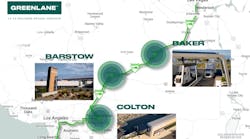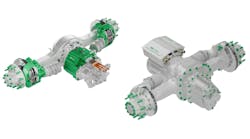Greenlane announces 280-mile corridor of commercial EV charging stations from Los Angeles to Las Vegas
Greenlane announced its first commercial EV charging corridor with more than 100 chargers, modern amenities designed to increase the comfort of drivers, resilience for high uptime, and ultimately moving freight more efficiently. Greenlane is a joint venture between Daimler Truck North America, NextEra Energy Resources, and BlackRock. The new charging corridor along Interstate 15 aims to accelerate the rollout of carbon-neutral freight transportation with initial charging locations in Colton, Barstow, and Baker, California. Further locations will be added along the corridor over the next year, extending beyond Southern Nevada and to San Pedro in California.
“After considering various factors, such as truck telematics data, frequent freight routes, and customer deployment strategy, the Greenlane team selected these three optimal locations for our first commercial charging corridor to accelerate the transition to zero emissions,” said Patrick Macdonald-King, CEO of Greenlane. “The launch of this corridor not only marks a critical step in addressing the urgent need for publicly available, nationwide electric charging for commercial vehicles but will also serve as a model for the EV charging hubs of the future.”
At full build, the Colton site is planned to have more than 60 chargers, including 400 kW direct current fast chargers to speed charging of medium- and heavy-duty zero-emission vehicles. More than 200 kW DCFC charging options on-site will enable long-duration and overnight charging for heavy-duty tractors, medium-duty ZEVs, and school buses. Greenlane will also deploy multiple passenger car charging stalls to support light-duty and passenger vehicles.
Later project phases will support both long-duration and overnight charging lanes for tractor-trailer combinations, as well. The Greenlane site in Colton will also be future-proofed to accommodate the megawatt charging system when commercially available.
See also: DTNA’s Greenlane using Uber Freight data to build out trucking’s first EV corridor
"By using a predictive modeling tool to simulate truck traffic and energy flow at the site, we can determine how many chargers are necessary to meet the regional demand based on vehicle characteristics and departure and arrival times for vehicles hauling freight along this corridor," said Macdonald-King. "Our findings indicated that placing the three stations approximately 60 to 90 miles apart would maximize uptime for day-cab drivers by enabling shorter charging sessions at each stop and ultimately allowing customers to move freight confidently without any limitations."
Designed to upgrade and enhance the current rest stop experience, each Greenlane site will have wide pull-through lanes, allowing drivers to enter and exit the property quickly and easily. While waiting for vehicles to charge, drivers can access modern facilities with restrooms and other amenities, including food and beverage options.
Greenlane aims to develop a nationwide network of commercial charging infrastructure locations across the U.S. The charging sites will also serve battery-electric passenger car and light-duty fleet customers and are designed to provide hydrogen refueling for commercial vehicles in the coming years.
Greenlane is targeting a spring groundbreaking on the Colton flagship site, aiming to open in late 2024. Located at the intersection of Interstates 10 and 215, the Colton hub will offer multiple ways for heavy-, medium-, and light-duty ZEV drivers to charge their vehicles.
With CARB rules looming, this is one of many attempts by the industry and federal government to transition trucking to electric vehicles.
Earlier this month, federal agencies released the National Zero-Emission Freight Corridor Strategy, a 318-page document to guide charging and hydrogen fueling infrastructure development for medium- and heavy-duty vehicles through 2040. The strategy aims to advance the Biden administration’s freight industry decarbonization goals by developing EV freight corridors.
Last week, a new study commissioned by the Clean Freight Coalition and conducted by industrial consultant Roland Berger found that electrifying the entire U.S. commercial trucking fleet could cost nearly $1 trillion.



